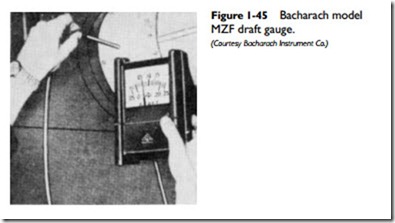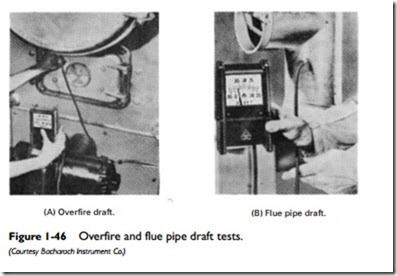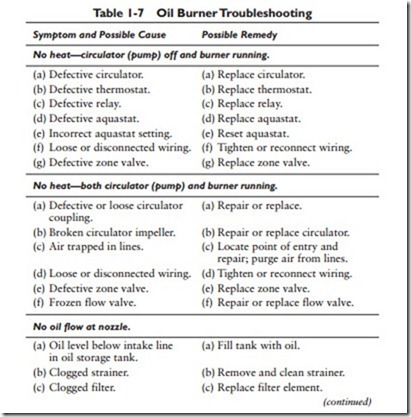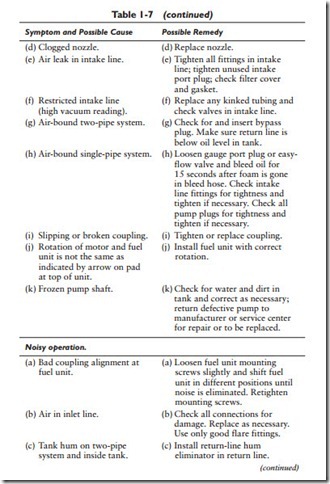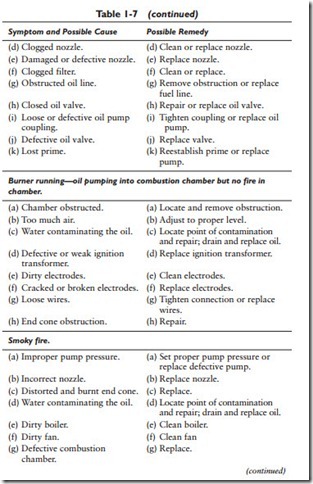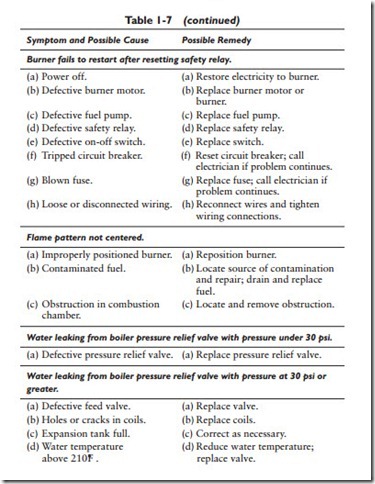Troubleshooting Oil Burners
Individuals involved in the installing and repairing of oil burners should be aware of a number of different indicators of malfunctions in the equipment, their probable causes, and some suggested remedies.
The average individual is most aware of malfunctions that warn the senses through excessive noise, smoke, or odor. These are external warning signals that require immediate investigation. Their nature is such that tracing the probable cause of the malfunction is made easier.
Excessive noise (pulsation, thumping, rumbling, etc.) in the heat- ing unit is generally caused by a problem with the oil burner nozzle. It can usually be corrected by any one of the following methods:
• Replace the nozzle with one having a wider spray angle.
• Replace the nozzle with one having the next size smaller opening.
• Install a delayed-opening solenoid on the nozzle line (this reduces pulsation).
Sometimes a noisy fire is caused by cold oil originating from out- side storage tanks. This noise may be greatly reduced or eliminated by pumping the fuel oil under 120 to 125 psi through the next size smaller nozzle.
Excessive smoke has a number of possible causes, including the following:
• The air-handling parts of the oil burner may be too dirty to operate efficiently.
• The combustion chamber or burner tube may be damaged by burn-through or loose materials.
• The oil burner nozzle may be the wrong size.
The dirty air-handling parts (e.g., the fan blades, air intake, and air vanes in the combustion head) can be made to operate more efficiently by a thorough cleaning. If the excessive smoke is caused by the oil burner nozzle, this can be corrected by replacing the nozzle with one that is a size smaller or one having the next narrower spray angle. A damaged combustion chamber is a more difficult problem to correct than the other two. In any event, all leakage through the walls must be eliminated before the oil burner can be expected to operate efficiently.
Excessive odors can be caused by flue obstructions or poor chimney draft. If the draft over the fire is lower than 0.02 to 0.04, it is usually an indication that the problem lies with the flue or chimney draft. The cause is usually an obstruction in the flue or poor chimney draft. Other causes of excessive odor include the following:
• Delayed ignition
• Too much air through the burner Delayed ignition is commonly traced to a problem with the electrodes. This condition can result from a variety of causes, including the following:
• Improper electrode setting
• Insulator cracks
• A coating of soot or oil on the electrode
• Incorrect pump pressure setting
• Incorrect spray pattern in the nozzle
• Clogged nozzle
• Air shutter open too far
Table 1-6 lists a number of recommended electrode settings that should eliminate delayed ignition if the electrode setting is the cause of the problem. The type of nozzle spray pattern can also result in delayed ignition. This is particularly true when using a hollow spray pattern in oil burners firing 2.00 gph and above. It can be corrected by replacing the nozzle with one having a solid spray pattern.
Table 1-7 lists a variety of problems encountered with oil burn- ers, many of which are of an internal nature and require a great degree of experience and training to correct.
